— By Kara Lynn Dunn, NYSG's Freelance Great Lakes Publicist
Ithaca, NY, May 12, 2022 - Small grants funding through a New York State Department of Environmental Conservation (DEC) collaboration with New York Sea Grant (NYSG) is creating big opportunities for sportsmen, residents, and visitors to access New York’s aquatic resources statewide. Herewith, we share an exciting and diverse sampling of the environmental enhancements and public access made possible by this funding partnership.
DEC-NYSG Small Grants Programs: Making Big Impact Possible
New York Sea Grant (NYSG) administers two distinct small grant programs — one in the Marine and Coastal District, one in the Great Lakes region with funding made possible by the New York State Department of Environmental Conservation. Funded projects have addressed coastal resiliency planning, species diversity, green infrastructure retrofit design, public water quality enhancement, harmful algal bloom mitigation, hands-on student and public education about fishing, fisheries, and coastal environments; and urban and Great Lakes waterfront access.
“New York Sea Grant is proud to partner with the DEC to implement these two innovative and impactful small grants programs that empower local stakeholders to holistically address Great Lakes Action Agenda issues and to promote education about, access to, and conservation of the State’s marine fisheries, coastal, and estuarine resources. The funded projects support solutions for enhanced sustainable and resilient communities as well as stewardship of New York’s diverse freshwater and marine environments, which also bring economic benefit to the coastal communities of New York State.” — Rebecca L. Shuford, Ph.D., New York Sea Grant Director
“New York’s coastal communities provide unique environmental, ecological, and economic value to New York State. These New York Sea Grant-DEC small grants programs energize stakeholders - of all ages - to take a positive and timely role in conserving, protecting, and enhancing their local, irreplaceable resources.” — Katherine Bunting-Howarth, Ph.D., J.D., NYSG Associate Director/Cornell University Cooperative Extension Associate Director
Marine and Coastal District (MCD) of New York Conservation, Education, and Research Small Grants
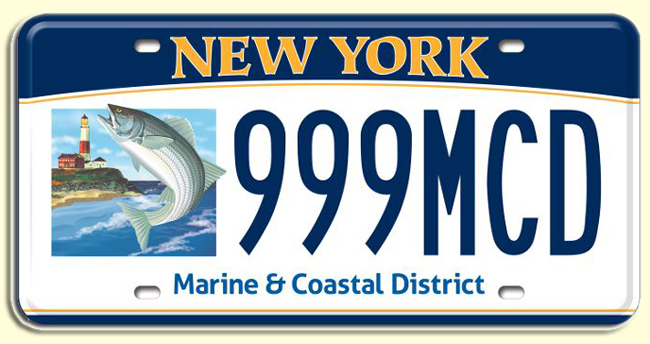
Environmental and fishing grant programs are funded collectively with $25 from the annual fee from each Marine and Coastal District license plate. Credit: New York Department of Motor Vehicles
In 2019, this program began providing grant funding supported by the sale of MCD license plates to support conservation and public appreciation of marine, coastal, and estuarine resources. Approximately $74,000 was awarded in the first cycle. Learn more at www.nyseagrant.org/marinesmallgrants.
“We are thrilled with the success of the first cycle of grants that created interactive learning opportunities across the district. The Board’s ultimate goal is to fund research and educational projects centered around the natural resources that define our State’s marine and coastal district. This small grants program supported projects of a diverse scope, allowing students and the public to attend fishing clinics and fishing trips and to assist with habitat restoration, and piloted a fabulous new ADA-compliant fishing structure.” — Melissa Dearborn, MCD Research Board Chair
Marine Small Grants: Highlights
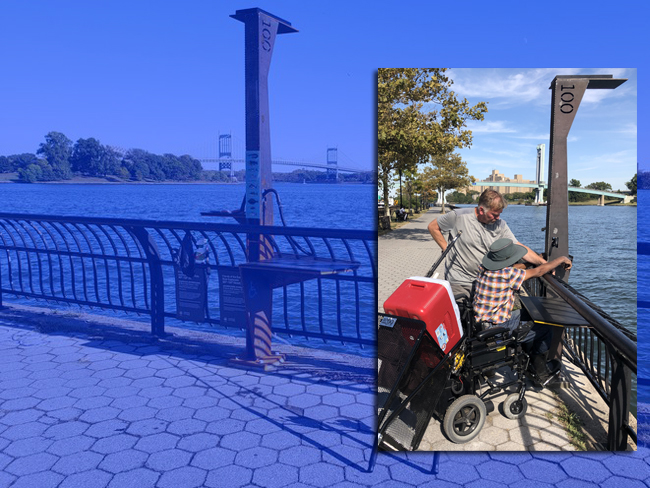
Credit: Chris O’ Brien, Friends of the East River Esplanade
East River ADA-Accessible Bait Station
In fall of 2019, anglers along the East River in Harlem were able to prepare bait and inspect and clean their catch from the first ADA-compliant bait station along the East Harlem waterfront. A $15,000 DEC-NYSG small grant to the Friends of the East River Esplanade provided for the architectural design and fabrication of a prototype station that would accommodate anglers in wheelchairs.
The El Barrio Bait Station was built with steel surfaces, a solar panel to power lighting and a water pump, and illustrations of 10 species of fish native to the East River. El Barrio fishermen, who prompted the idea for such a resource, provided input for the station’s design; local contractors built the unit pro bono. The East River Bait Station at 100th Street is at a prime location for fishing.
This project won a 2020 Municipal Art Society of New York MASterworks Best New Infrastructure Award, and the 2021 American Institute of Architects NYS Excelsior Award in Public Art.
For more, see "License Plate Funds Support Small Fishing and Environmental Projects With Big Impacts".
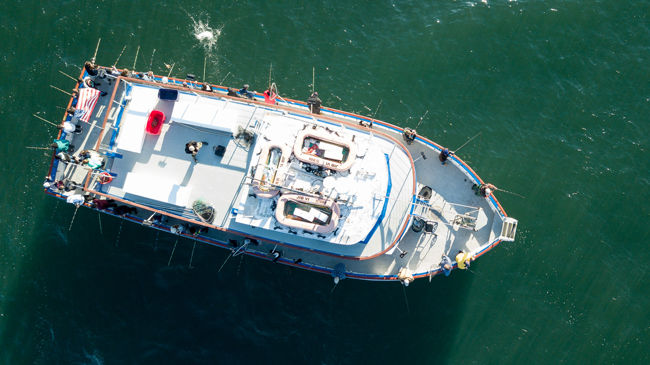
Brentwood Union Free School students participated in fishing trips as part of a DEC-NYSG small grant opportunity. Credit: Rebecca Grella, Ph.D.
Encouraging Student Environmental Connections and Innovation
New York State’s largest suburban school district, the Brentwood Union Free School District on Long Island, serves approximately 19,000 students. A DEC-NYSG small grant in 2019 was timely in advance of the pandemic shutdown as it funded remote learning opportunities related to aquatic research as part of the school’s “No Child or Teacher Left Inside” environmental education initiative.
Brentwood’s young scientists tell about their prize-winning project
With a theme of “Let’s Science That,” Brentwood’s 10th-12th grade students developed social media, a website, a YouTube channel, and a podcast to communicate about their research and projects focused on invasive species, nitrogen levels in the salt marsh at Sunken Meadow State Park, and other timely issues. Their documentation of an investigation into the use of natural food additives to curb salt marsh erosion earned a $15,000 award in prizes from the Samsung Solve for Tomorrow competition.
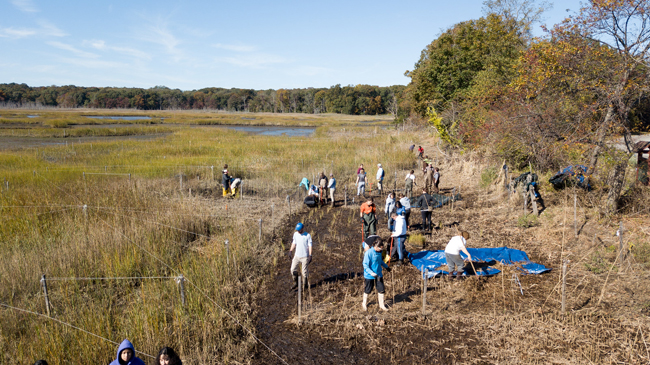
Brentwood Union Free School students participated in salt marsh restoration efforts at Sunken Meadow State Park as part of a DEC-NYSG small grant opportunity. Credit: Rebecca Grella, Ph.D.
“It is imperative that we encourage all students to be stewards of the environment. With the assistance of the Marine and Coastal District grant program, we were able to connect Brentwood students with nature and give them a voice in preserving and protecting the environment. Our ‘Let’s Science That’ program does exactly that, gives students a voice!” — Rebecca Grella, Ph.D., Research Director, Brentwood Union Free School District
New York Great Lakes Basin Small Grants
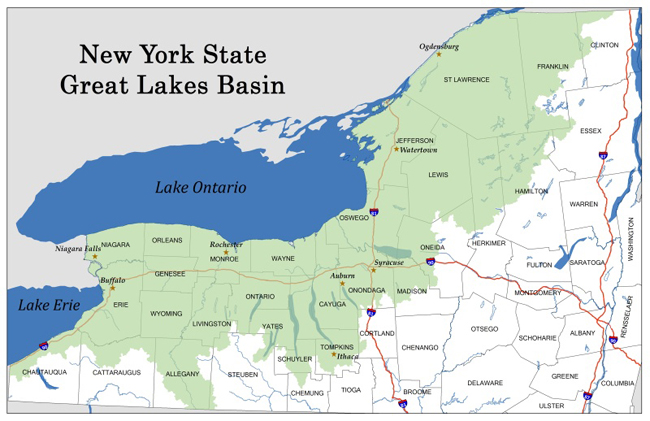
Since its inception in 2015, this program has awarded more than $1.2 million to projects addressing the needs, issues, and opportunities identified in New York’s Great Lakes-St. Lawrence River watershed communities. The funding is provided through the New York State Environmental Protection Fund and Article 14 of NYS Environmental Conservation Law. Learn more at www.nyseagrant.org/glsmallgrants.
“This program sparks local stakeholder-driven projects designed to demonstrate ecosystem-based approaches to protect our natural resources, enhance environmental quality, and support environmentally-themed economic development across New York’s Great Lakes region. Projects accomplished with these small grants create a real-world foundation for leveraging larger subsequent funding.” — Donald Zelazny, NYSDEC New York Great Lakes Basin Programs Coordinator
Great Lakes Small Grants: Highlights
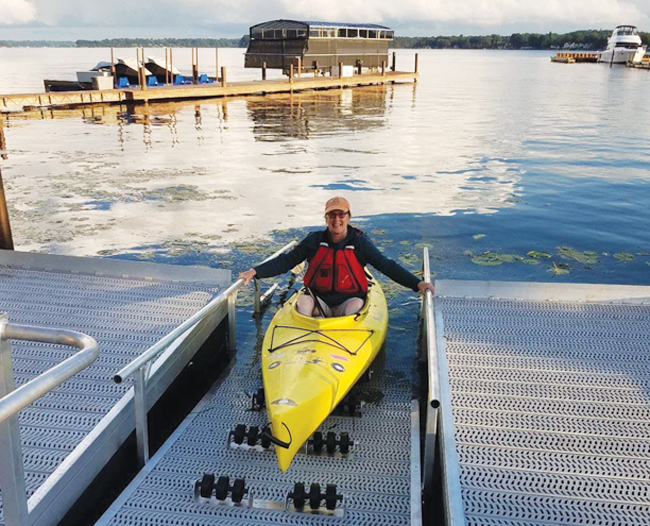
Credit: Maxine Appleby
Great Sodus Bay ADA Canoe & Kayak Launch
A DEC-NYSG small grant helped the Village of Sodus Point respond to residents’ interest in having non-motorized access to Great Sodus Bay by installing an ADA-compliant canoe and kayak launch at the end of South Ontario Street in 2019. Maxine Appleby, who spearheaded the project as a Wayne County Board Trustee, notes, “We were multi-focused on developing an eco-tourism destination that would provide water access to people of all abilities, serve as a gateway to a Sodus Bay paddling experience, and incorporate green infrastructure elements to naturally preserve the shoreline along the bay at the launch site.”
“This launch is becoming more and more a destination and one more reason to visit Sodus Point. Whatever your ability, this launch is easy to use. The ramp connects to a floating dock and has a roller, bars, and grips that let you quickly slide into the water without getting wet, or pull yourself up and out. Great Sodus Bay is gorgeous and puts you right in the middle of nature with abundant wildlife and waterfowl. You can paddle out to Lake Ontario, kayak and fish, or explore the marshes.” — Kathy Madison, President, Neighborhood Association of Sodus Point
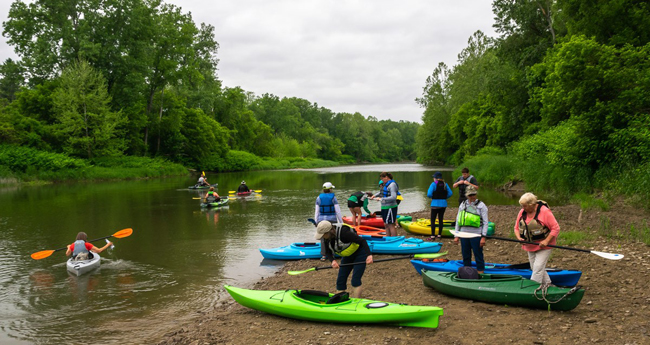
Kayakers enjoying the Genesee River. Credit: Genesee RiverWatch
Riding the River: Mapping a 165-Mile Blueway
The Genesee River flows over progressively-older bedrock of sandstone, shale, and limestone as it runs 165 miles from Pennsylvania to Lake Ontario. A 17-mile stretch passes through scenic gorges and over three major waterfalls in Letchworth State Park in an area dubbed “the Grand Canyon of the East.” Farther north, the river’s energy powered flour and clothing mills in 19th-century Rochester.
“This blueway project helps make our river safer and more accessible, and increases public awareness of the recreational and ecological significance of the River. In broader terms, it fits with our strategic planning that encompasses environmentally sustainable conservation, recreation, natural flood control, education, and economic development.” — Thomas Rhett, Genesee River Wilds President
A collaborative effort by the Genesee RiverWatch, Genesee River Wilds, and Genesee Valley Conservancy drew on public input, a riverside sites inventory, aerial imaging, and GIS data to update the Genesee River Basin Canoe/Kayak Access Map, and identify areas for enhancing river access and signage.
As of April 2021, paddlesport enthusiasts in colorful kayaks and canoes can more easily locate launch points and take-outs with the updated map, mile markers, and new reflective signage.
“A critical piece of the Genesee RiverWatch mission is to connect people to the river, encouraging them to explore, experience, and celebrate the river. This grant project helped us create products to build awareness.” — George Thomas, Genesee RiverWatch Executive Director
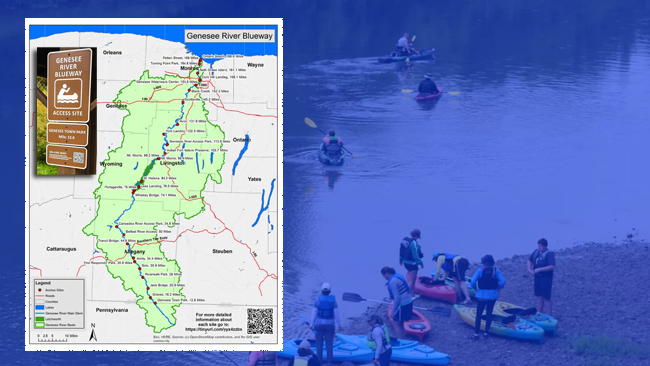
(At left) An updated Genesee River Basin Canoe/Kayak Access Map and (inset) signage have enhanced the River experience. Credit: Genesee RiverWatch
Access/download overview and interactive Genesee River Blueway Maps: www.geneseeriverwatch.org/the-genesee-river
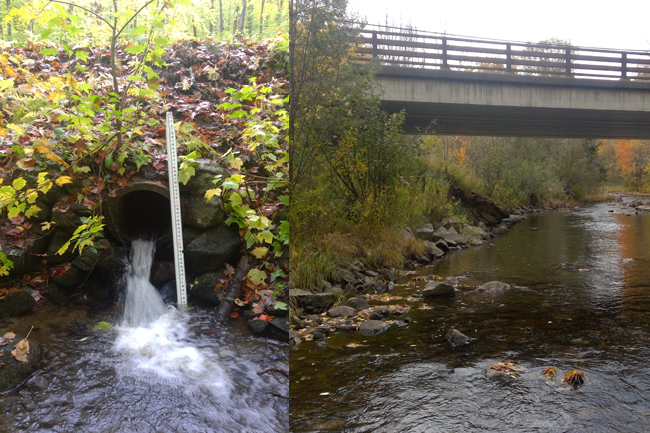
(At left) Passageway with outflow drop in need of attention. (At right) Open-flowing stream. Credit: Kristin Ballou/Franklin County SWCD
Open Passage for Aquatic Species in Franklin County
Open-flowing streams and rivers provide for mobility, seasonal migration, spawning, species diversity, and survival for aquatic life from fish and frogs to food web macroinvertebrates (snails, worms, etc.). Open water beneficiaries also include local economies that reap revenue from paddlesport, sportfishing, and nature tourism activity. Blocked waterways can disrupt the natural food web; reduce habitat, such as pooling areas where fish congregate; and geographically and genetically isolate aquatic species.
In 2019-2020 the Franklin County Soil and Water Conservation District (FCSWCD) applied a DEC-NYSG small grant to evaluate road-stream crossing structures in the Chateaugay-English River watershed. The funding helped connect Franklin County to the 13-state North Atlantic Aquatic Connectivity Collaborative (NAACC) and its evaluation, scoring, prioritization, and design resources. The assessment applied the NAACC protocol to identify and rank structures that impact aquatic passage and habitat.
“We initially planned to assess the 134 predicted crossing sites in the NAACC database. Once we started, this grant made it possible to not only evaluate those sites but to field-truth and add nearly 200 more structures to the database.” — Kristin Ballou, FCSWCD Forester
This project contributed to New York State’s interest in building a foundational inventory of culverts’ status to begin addressing barriers to continuous fish movement through river and stream systems statewide. FCSWCD is working with municipalities on funding opportunities to address culvert repair and replacement needs.
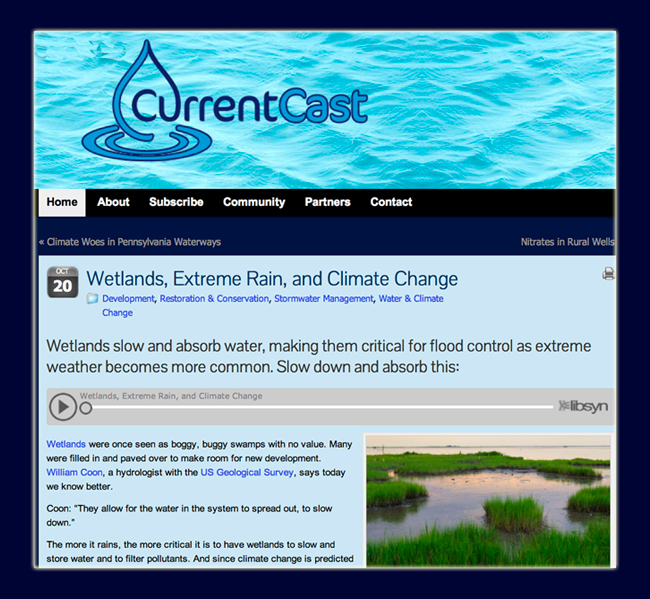
Information Bursts Invite Interest in Aquatic Issues
With DEC-NYSG small grant funding, the Center for Transformative Action at Cornell University produced short radio- and social media-friendly information bursts and podcast segments about Great Lakes issues and activities, including stormwater management, erosion, riparian restoration, wetlands, green infrastructure, harmful algal bloom risk to pets, and Great Lakes research. Learn more at www.nyseagrant.org/currentcast.
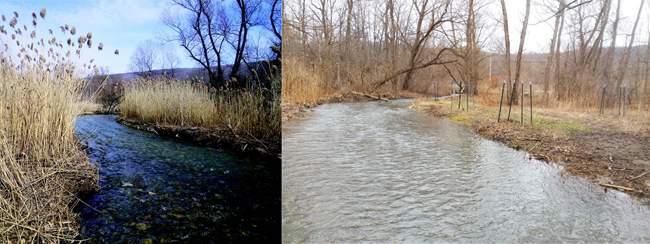
Before & After — (At left) A pre-restoration stretch of Onondaga Creek looking downstream; (At right) The same area, facing upstream, after the small grant-funded restoration work. Credit: Onondaga Environmental Institute
Restoring Habitat for New York State’s Fish
The official New York State Fish is the native brook trout (Salvelinus fontinalis), a coldwater species. Onondaga Creek and its West Branch tributary were productive coldwater fish habitat until urban development and the eruption of the Tully mudboils of salt water, silt, and clay from salt brine mining activity degraded the aquatic environment. By the mid-19th century, wild brook trout had declined almost to non-existence in the Upper Onondaga Creek watershed that feeds Onondaga Lake.
With successful application for a DEC-NYSG grant in 2016, the Onondaga Environmental Institute (OEI) undertook ecosystem-based management activities to naturally enhance Onondaga Creek for the purpose of restoring native brook trout populations. Project partners included the Onondaga Nation and Onondaga Earth Corps. Efforts ranged from streambank stabilization and native species planting to repairing two failing culverts that were creating water flow and passage chokepoints.
The project’s volunteer and educational programming engaged local communities and youth in meaningful, place-based experiences and has fostered long-term stewardship interest.
Today, the OEI continues to work with Onondaga County, Onondaga Nation Tribal agencies and local landowners to monitor and maintain the habitat quality that allows the coldwater trout to successfully spawn and survive.
Anglers should respect posted, private, and Native lands. Access may be limited to bridge crossing rights-of-way and public land.
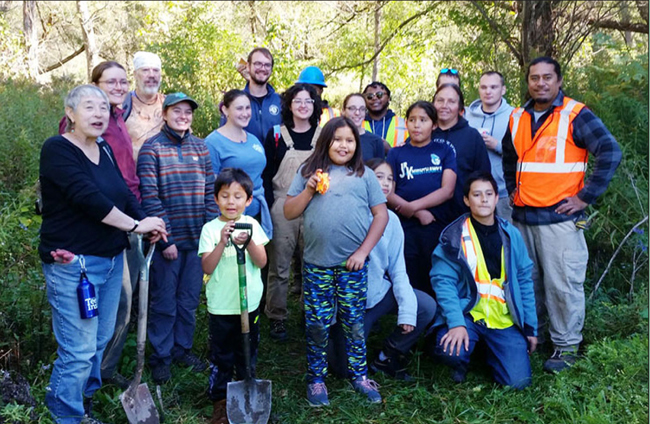
Local stakeholders supported a tree planting event along Onondaga Creek. Credit: Onondaga Environmental Institute
“Through this project, and in cooperation with previous New York Sea Grant small grants funding, we have been able to successfully restore and renaturalize more than 5 acres of riparian habitat by removing invasive Phragmites and buckthorn, and planting nearly 130 native trees. We are already seeing the positive effects of this restoration, with brook trout captured in the project area for the first time in more than 10 years.” — Stephanie Johnson, Ph.D., OEI Project Scientist and Aquatic Biologist
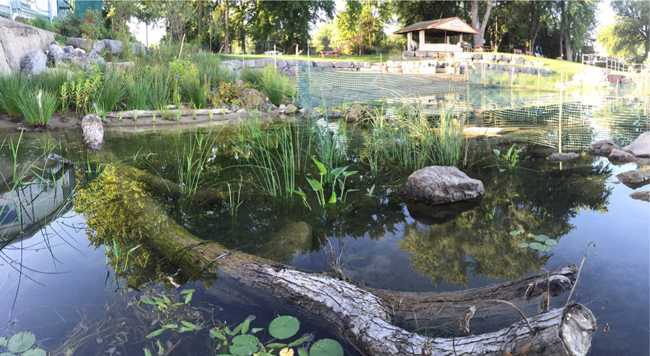
A Grand Island living shoreline demonstration area. Credit: Buffalo Niagara Waterkeeper
Protecting Grand Island’s Niagara River Coastline
Buffalo Niagara Waterkeeper received a DEC-NYSG small grant to create and implement education and outreach programming to inform and engage the community on best management practices to encourage resilient shoreline habitats along a unique stretch of Grand Island shoreline in western NY.
A living shoreline demonstration project encouraged local residents with nearby private properties to plant native species to reduce erosion and filter stormwater runoff rather than mowing and fertilizing all their yard space. Workshops presented information on how to recognize and replace invasive species, such as mugwort and common buckthorn, with native species.
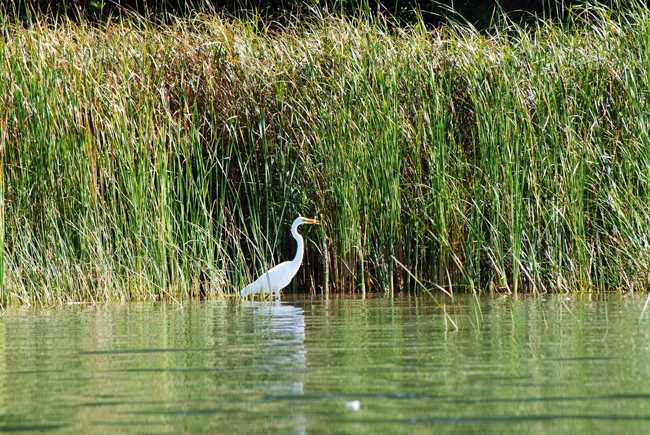
A Great Egret in the Niagara River at Grand Island. Credit: Buffalo Niagara Waterkeeper
“This small grant project was an investment in educating the public about the unique value of Grand Island’s western shoreline of the Niagara River as the longest stretch of undeveloped waterfront in the area.” — Emily Root, Director of Ecological Programs, Buffalo Niagara Riverkeeper
This shoreline area now includes a non-motorized use walking trail for birders, bicyclists, rollerbladers, and snowshoers as well as access for angling, launching kayaks, and using hunting blinds. The area, rich in fish and wildlife, is a globally-designated Important Bird Area.
More Info: New York Sea Grant
New York Sea Grant (NYSG), a cooperative program of Cornell University and the State University of New York (SUNY), is one of 34 university-based programs under the National Oceanic and Atmospheric Administration’s National Sea Grant College Program.
Since 1971, NYSG has represented a statewide network of integrated research, education and extension services promoting coastal community economic vitality, environmental sustainability and citizen awareness and understanding about the State’s marine and Great Lakes resources.
Through NYSG’s efforts, the combined talents of university scientists and extension specialists help develop and transfer science-based information to many coastal user groups—businesses and industries, federal, state and local government decision-makers and agency managers, educators, the media and the interested public.
The program maintains Great Lakes offices at Cornell University, University at Buffalo, SUNY Oswego and the Wayne County Cooperative Extension office in Newark. In the State's marine waters, NYSG has offices at Stony Brook University and Cornell Cooperative Extension of Nassau County on Long Island; at Brooklyn College, with New York City Department of Environmental Protection in Queens and at Cornell Cooperative Extension in NYC and Elmsford and Kingston in the Hudson Valley.
For updates on Sea Grant activities: www.nyseagrant.org has RSS, Facebook, Twitter, Instagram, and YouTube links. NYSG offers a free e-list sign up via www.nyseagrant.org/nycoastlines for its flagship publication, NY Coastlines/Currents, which is published quarterly.